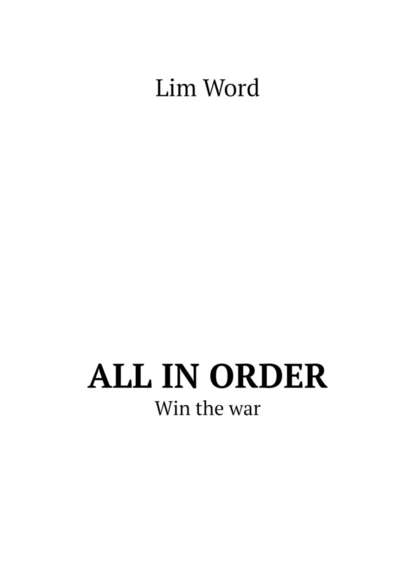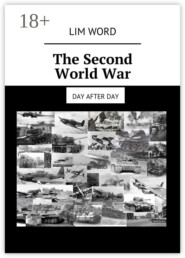По всем вопросам обращайтесь на: info@litportal.ru
(©) 2003-2024.
✖
All in order. Win the war
Настройки чтения
Размер шрифта
Высота строк
Поля
Dunkirk through a German camera
The car in Compiegne Forest (France), the very one in which the Treaty of Versailles, humiliating for Germany, was signed 22 years ago. The capitulation of France, or, more precisely, of its northern half, is taken once by the glorious Marshal Petain, the hero of the First World War (right in the center)
The occupation of half of France, Germany and Italy, 1940. In Toulon, the main part, maintaining a high degree of combat capability, is based on the French fleet. The resort city of Vichy becomes the capital of the new government
German children and soldiers welcome the success of Nazi Germany, 1940.
On the night of July 3, 1940, British divisions seized the French warships stationed in British ports. It does not do without bloody incidents, several people die on both sides. The meaning of this operation is not to allow the French, if they so suddenly wish, to transfer their fleet to the Germans (or, even more so, to go over to their side). Similar actions are also being taken in all the bases of the Mediterranean Sea, where the ships controlled by the Vichy government are located. In the Egyptian port of Alexandria, the initiative of the British captain-negotiator allows us to arrive at a reasonable compromise. In July 1943, the battleship, four cruisers and several destroyers join the Anglo-American allies. But, in other places everything is much, much more complicated. Photo – Mers-el-Kebir Harbor, June 1940.
To neutralize part of the French fleet, which is in the harbor of Mers-el-Kebir (Algeria), the British are equipped with a squadron of three battleships, two cruisers, an aircraft carrier and eleven destroyers. In the ultimatum, the French demanded: go to the ports of the West Indies, or flood their own ships. The British commander orders to open fire at 16.45, without waiting for the expiration date of the note presented to him. Shells cover the bored, anchored battleships, cruisers, destroyers, navigational vessels and submarines. Three battleships receive hard-to-repair damage and are stranded. Survivors finish off torpedo bombers from the aircraft carrier “Ark Royal”. One battleship, the newest “Strasbourg”, taking advantage of the short-lived lull and the help of a destroyer who removed some of the minefields, leaves for Toulon. On the way this serious ship meets almost board to board, almost defenseless now, the British “Ark Royal”, but the captain orders the fire not to open. The English do not appreciate such a nice gift and send six “Swordfish” to Strasbourg. Anti-aircraft guns left without damage to the battleship knocked down two aircraft
Similar battles will also take place in Dakar (French North Africa, now Sinegal). Attack on a group of ships in the West Indies, the island of Guadalupe, prevents the intervention personally of the US President, Franklin Roosevelt. For two days “Catapults” France loses 1,400 people, England -2 pilots and 6 aircraft. In addition, tens or hundreds of thousands of French with an easy heart become collaborators. Photo – French ships breaking from the harbor of Mers-el-Kebir
The Richelieu battleship (displacement 27,000 tons), which was seriously damaged in the port of Dakar, is subsequently bought from France by the US government. Powerful 380 mm. guns are drilled to the appropriate American standard, and, after this war they are firing off the coast of Burma. But the most interesting is contained in the holds of this elegant, aureole-covered secrets of the ship. It was the gold of the French National Bank, and also of Poland, Belgium, and the Netherlands, only $ 2.5 billion of that time. What happens to the precious metal further, and by what agreement it falls into the hands of the Americans, we just do not know. It is believed that in 1945 its monetary equivalent was transferred to the countries of Europe, under the Marshall Plan, as a loan for exclusively American goods
From July 10 to October 30, 1940, Britain and Germany are engaged in a fierce battle in the air. As a result, England loses a little more than a thousand aircraft, its opponent – 1800 combat vehicles. In Western historical literature, this result is considered to be the greatest battle of its time, which will be remembered for thousands of years. The air battle for the Kuban (RSFSR, 1943) is characterized by similar numbers of downed aircraft, but, for some reason, remains in the shadows. Actually, in the Soviet and Russian historiography, the air battle for Britain is also a relatively insignificant episode, among the really epic land battles on the territory of the Soviet Union. Be that as it may, Germany loses interest in the UK and focuses entirely on preparing an invasion of the USSR. Photo – raid of Luftwaffe bombers to ships in the English port of Dover, 1940.
The Government of the USSR sends an ultimatum to the Romanian government demanding the return of Bessarabia (the former Russian province that was rejected by Romania in 1920) and Northern Bukovina as compensation for the exploitation of the population of Bessarabia (June 27, 1940). A few hours before the start of the Soviet invasion, the Romanian king accepts all conditions. The received lands are divided between the Soviet Ukraine and Moldova. In total, the USSR receives 3.7 million people and 50 thousand square meters. km. territory. About 28,000 heads of the most well-to-do families are deported to Siberia (relatively few)
The population of Bessarabia, indeed, undergone many humiliations and terror from the Romanian authorities, as a whole is loyal to the Soviet government. Ethnic Romanians and Ukrainians (85%) Bukovina, 0.8 million people who did not feel this kind of attitude, are annexed without much enthusiasm. In the photo there is a parade of Soviet troops and a festive folk demonstration in Chisinau, July 3, 1940.
Representatives of the young generation of Bessarabia (Moldavia) present flowers to the Red Army soldiers
In October 1940 the Soviet Union invites Estonia, Latvia and Lithuania, under a mutual assistance agreement, to deploy a military contingent of 25,000 troops on their territory to defend themselves against Hitlerite Germany. It is already clear that the Red Army is inclined to achieve its goals, regardless of any losses. Two weeks later, the governments of these countries are accused of collusion with Germany (which is partly true), repressions against foreigners (Poles, etc.) and are shifting. In the summer of 1940, following the results of nationwide voting, the republics are formed by communist governments and adopt declarations of entry into the Soviet Union; which are immediately approved by the Supreme Soviet of the USSR. According to documents of the NKVD of June 17, 1941, in Lithuania – 5663 persons, mainly employees of the secret police and “classical capitalists” were subjected to confinement – 10186, Latvia, respectively, 5624 and 9547, Estonia – 3179 and 5979. Lithuanian President Antanas Smyatona wisely emigrates to Germany, then to Switzerland and the USA. His Estonian counterpart Konstantin Päts is deported with his family to Siberia, receives 25 years of camps, since 1942 is kept in a prison psychiatric clinic, he died there in 1956. The head of Latvia, Karlis Ulmanis convinces the people that “friends have come”, actively cooperates with the new, pro-Soviet government, and in particular, publishes the “Law on the Fight Against Wrecking”. Somewhat later he begins to understand the situation, asks the Kremlin for permission to travel to Switzerland, but eventually ends up in the NKVD camp near Krasnovodsk (Turkmenistan), where, in 1942, he dies. Photo – a demonstration of the population of Latvia for joining the Soviet Union. May-June 1940
Karlis Ulmanis, Head of Latvia
Anastastus Smyatona, prudent leader of Lithuania
Konstantin Päts, Head of Estonia
Parade, or at least a demonstration of Soviet troops in Riga, summer 1940.
Soviet (Russian) soldiers in Riga, 1940. I believe that none of them wishes evil to any of the inhabitants of the three Baltic countries. Every person in this column considers himself, if possible, a bearer of good and a hero – a liberator. Evil is only a general idea in the all-powerful ruler, which in this case is (non-Russian) Joseph Stalin and his, formed on 90% of the representatives of Jewish nationality, a repressive apparatus… It’s not me
Since July 1940, the battle for the Atlantic has become extremely acute. Germany receives new naval bases. France withdraws from the war, and fascist Italy, on the contrary, enters it. The photo shows the death of the British heavy cruiser Hood, the morning of May 24, 1941. Before that, the ship is marked by the conduct of Atlantic convoys and, notice, the flooding of the battleship Brittany, during Operation Catapult. With life more than a thousand French sailors are forgiven. Now, “Hood”, as part of a group of battleship and 6 destroyers, goes to intercept the German battleship Bismarck and the heavy cruiser Prince Eugen. The British cruiser opens fire from 24 km. and at full speed moves closer with its opponents. A volley of one of the German ships covers the unfolding “Hood” from a distance of 15—18 km. The cruiser for a while follows the same course and, a kilometer from the “Prince Eugen” (probably there and made this picture) as a result of a powerful explosion breaks in half. A hail of debris falls on the German cruiser. 1415 people are dying. Only 3 sailors survive
The German battleship Bismarck, the world’s largest ship of its time. Displacement fully equipped – 50 000 tons (twice as high as the average aircraft carrier), length 251 m, width 36 m, draft 10 m. Speed maximum 55 km. h, the range of autonomous navigation is 17,000 km. The main armament is eight 380 mm. guns in four towers.
In the evening, the same May 24, 1941, “Bismarck” receives a torpedo on board from one of the seven torpedo bombers “Swordfish”, taking off from the deck of an approaching aircraft carrier. The British are extremely sensitive to the death of the cruiser “Hood” and intend to at all costs get rid of the German battleship. The torpedo hits the main armored belt (145—320 mm.) And does not produce any special action. One sailor perishes. The attack from the air is repeated on May 25, and more successfully. One of two or three torpedoes damages the steering, so the ship begins to describe the circulation (to move forward in a spiral). In this state, “Bismarck” has to take a fight with two battleships, a heavy cruiser and several destroyers. German submarines to help him come do not have time. In the photo – the last minutes of the flaming superlinkor
The roll negatively affects the accuracy of the firing of the Bismarck guns. British shells destroy the main range-post and damage the gun turrets. Then the English heavy cruiser hits the super-ship with three torpedoes. The ship is turned upside down with a keel. Of the 2220 people, 114 are being saved (three are taken by a German submarine coming up). Since then, the German command hides the strike forces of the surface fleet, primarily in the winding Norwegian fjords, and does not give them the opportunity to once again face off against the British. German Kriegsmarines are moving to the tactics of unlimited submarine warfare. If before that, before the ship was flooded, the crew of the submarine was obliged to give the appropriate signals, and to wait for the sailors to transfer to the boats, now such tenderness is no longer there. Photo – the surviving sailors of the Bismarck board aboard the British ship
The Prime Minister of Yugoslavia signs a protocol on the accession of his country to the Tripartite Pact, March 25, 1941. On the same day, in Belgrade, an 80,000-strong demonstration against the alliance with Germany is taking place, marking, among other things, the defeat of the German Information Bureau. A new government is being formed, on April 5 the USSR and Yugoslavia are signing a treaty of friendship and non-aggression. These events Hitler views as an excuse for an invasion. And, on April 6, the armed forces of Germany, Italy, Hungary enter Yugoslavia. Stalin does not hasten to render assistance, in accordance with the concluded agreement. On Belgrade, 2,000 tons of bombs fall, and on April 16 the Yugoslav army surrenders. About 344 000 people are taken prisoner (Croatians, Hungarians and Germans – Volksdeutsche are later released). Irreversible losses: Germany 165 people, 40 aircraft, 3 tanks. Italy 3300 people, 13 aircraft, 11 tankettes. Hungary 130 people, 1 airplane. Yugoslavia: 5,000 military, 57 downed, 150 aircraft destroyed on the ground. In the photo, the Yugoslavs are celebrating the signing of an agreement on friendship with the USSR, April 5, 1941.
talian bersaliers (arrows of elite units) on the street of the Serbian city, April 1941.
For some political reasons, the seizure of Yugoslavia prompts Hitler to render more effective assistance to his Italian allies. And, on April 6, 1941, from the territory of Bulgaria, German troops invade Greece. Athens is captured on April 27, after another three days Greece will capitulate. A month later, the Wehrmacht invaded the island of Crete, considered primarily as an airfield for control of the Luftwaffe in the Mediterranean. In the photo – coastal Greek city after shelling with artillery of the Wehrmacht. April 1941
The brave but poorly armed Greek soldiers are preparing to meet the German troops. April 1941, Greece
The large losses of paratroopers do not allow further operations to be carried out to capture Cyprus and the Suez Canal immediately. Losses of Greece: 14,000 killed, allies 900, with 14,000 prisoners, the Wehrmacht 1,450 killed, Italy – about 20,000 people. It is believed that the need to seize Yugoslavia, as well as the stubborn resistance of Greece, delayed the beginning of the invasion of the USSR from May 15, 1941 to June 22, and these five weeks had a decisive effect on the course of the entire war. It seems that Serbia has returned the debt of Russia, since 1914. In the photo – German soldiers deploy a Nazi flag near the Athenian Acropolis. April-May 1941
In the Battle of Crete (May 20—31, 1941) the decisive force is the German paratroopers. On both sides perish about 5 thousand people. More than 5 thousand Greeks and 12 thousand allies (Englishmen, New Zealanders, Australians) are taken prisoner. The operation as a whole is successful, but since then the German command has refused to practice large parachute assault forces. Such a decision by Hitler allows Britain to retain the strategically important island of Malta
Count the forces of the warring parties. The population of the Soviet Union according to the results of the 1939 census is 170 million. It should be borne in mind that the leaders of the 1937 census, who showed the result of “only” 162 million for “undercounting” of the population, were shot. In 1940, territories with a population of 18 million people were annexed to the USSR, though not always loyal to the new system, having a different mentality. We assume that the results of the “shot” population census are the only correct ones, then by 1941 the population of the colossal state was 180 million people. The Third Reich, 1941, ie, Germany, Austria, the Sudetenland and some other territories inhabited by ethnic Germans subject to conscription – 90 million people. Hungary – 9.3 million (there were 800,000 Hungarians killed on the Eastern Front), Romania – 20 million (453,000 people died). These two countries are the unconditional allies of Germany, whose human reserves it could dispose of as its own. The contingent of volunteers in 64 thousand was allocated by 44 million Italy (during the war years the corps was renewed several times, 374 thousand were killed), and 25 million Spain – 18 thousand hours (irretrievable losses of 15 thousand). Slovakia – 36 thousand hours, 3 thousand people died, Croatia 2,200 people, the number of dead is unknown, Finland – about 300,000 people, losses of 70,000 (against 108,000 Soviet losses on this front, including 18,000 people killed in captivity)Wehrmacht also owned resources, the industry of France, Norway, Belgium, Holland, Denmark, Poland, Greece, Bulgaria, Yugoslavia and the Czech Republic. German soldiers on the border with the Soviet Union conduct reconnaissance, June 21, 1941 Left – 20 mm. automatic anti-aircraft gun 2 cm FlaK 30, to the right – an early-release T-4 tank, with short-barreled 75 mm. tool
The only ally of the USSR at the time is the 47 millionth Great Britain with 1.2 million (including parts located in the colonies), battered after the Dunkirk army. Her war with Germany until 1944 is similar to a ritual battle, a knight tournament, where, according to established rules, knights with knuckled gloves and all sorts of ammunition seize. England had fifteen thousand aircraft, a dozen aircraft carriers, many cruisers, destroyers and submarines. After Dunkirk, the British did not have more than 100 tanks, but thanks to the developed industry, their number constantly increased. Fought here rather, the technique, not people. The interest of Germany, whose people’s spirit is now ruled by the ancient German gods, lies in the Northeast. According to the plans of the Hitlerite command, German colonies on the territory of the USSR should be organized on the model of Ancient Sparta, with an autochthonous population reduced to 50 million, turned into slave-helots, respectively. In the photo – Soviet pilots before the fighters I-15 or I-16
Since June 22, 1941, Germany and Romania have joined the war with the USSR. The basis of military operations for Bucharest is understandable – the year-earlier exclusion of Bessarabia and Northern Bukovina. A day later, Slovakia entered the war. On 26 June, Kosice, which was Slovakia three years earlier, was bombed by unmarked aircraft, but, at that time, Hungary. 27 tons of bombs were dropped. It is still unclear whether this was the Soviet air force, bombed the city because of the confusion and obsolete maps, Germanic or even Romanian (to push the opposing ally to active action), but on June 27, Hungary declared the USSR a war. Almost at the same time, on June 25, Soviet aviation strikes at several settlements and 18 Finnish airfields. On some of them, German planes were actually based, formally, Finland was one of the Axis countries. On the same day, Suomi declares war, and by the end of the year he occupies a large part of Karelia, including its capital, Petrozavodsk (which has become Einislinna). About 70,000 civilians (from non-Finn-related peoples, according to racial anthropological surveys) are taken to Finnish concentration camps. Later, one third of them will die from malnutrition, disease and ill-treatment. Photography – and failed to take off (or made a forced landing) Soviet fighter I-16. The mass of the equipped aircraft is 1300 kg., The speed is 450 km. h, flight range of 480 km., armament – two rapid-fire machine gun 7.62 mm. Produced about 10,000 units. The second half of June 1941, the USSR
The Soviet fighter I-16, shot down on take-off, June 22, 1941.
The “Decree of Military Jurisdiction of the Barbarossa Plan” of 13 May 1941 states: “For actions that Wehrmacht servicemen and allies commit against the enemy civilian population, there is no prosecution, even if this action is simultaneously military crime or misdemeanor… I release you from the chimera, called conscience. “Further on this topic: “I reject Christianity, because it is the product of Judaism, because it is internationalistic and because it preaches peace on earth.” (Adolf Gitler). In general, we can say that the entire people of the USSR, the Soviet Army (RKKA), are moving towards God during the war, and Germany (the Axis countries), on the contrary, step by step, move away from it. “Got mit uns”, i.e. “God is with us,” the inscription engraved on buckles of belts becomes an empty formality. In the second half of the war, the funeral rites of SS men are most often conducted, according to the pagan custom of the Vikings, with the Lebens rune (the rune of life, something like an arrow pointing downwards, or a trident, or Toten-Rune, or Tyr-Rune) on the grave, instead of a cross. In the prewar picture – the military pilots of the USSR near the I-15 fighter. These people have to understand what total war is, and make almost impossible
Since June 23, 1941, the battle starts for Dubno-Lutsk-Brody (320 km west of Kiev). The General of the Army G. Zhukov, who came to the scene, rejects the idea of the Chief of Staff of the South-Western Front to withdraw troops and create a solid defense line. The new plan was an immediate strike by five mechanized corps in 2,800 (later 3,100) tanks for four (subsequently – five) German tank divisions of 720 tanks and 70 assault guns. Photo – German soldiers visiting the abandoned Soviet heavy tank T-35. Weight 50 tons, 11 crew, reservation – forehead 30 mm., Board 20 mm., All towers 20 mm. The real speed for rough terrain is 10—12 km. h. Armament – one 76.2 mm, two 45 mm. guns and six to seven machine guns. Made 59 units. Until June, tanks in military operations do not participate, confining themselves to demonstrating the power of the Soviet Union in military parades
Wehrmacht connections, in addition to combat vehicles, include large units of infantry, artillery, and also highly skilled repair brigades. Bulky (about 400 tanks) mechanized corps of the Red Army make marches of 300 km, losing at least only a mechanical breakdown of at least a third of the machines. The Soviet system of production of military equipment allegedly does not provide for the release, delivery, not even worth a half-word, of “small things” for repair, for example, gaskets or spare trains. Guidelines for driving and servicing the newest tanks, at this time – are classified even from potential mechanics. Sometimes, so carefully stored from the crews of the car, at the decisive moment refuel not with diesel fuel, but with gasoline. Approximately the same situation in the Air Force. In order to avoid any breakdown of equipment, getting accusations of wrecking, the most unfortunate consequences, the lower command is gradually sabotaging real military training. To realize how this or that thing works, one must at least break it down – it’s a simple, but an immutable truth. The fact that in the German educational units is punishable with salty jokes or a reprimand to a newcomer, the Red Army may end in execution. In the photo – the Soviet tanks BT-7 damaged and abandoned by crews. Weight 14 tons, crew 3 people, reservation 15—20 mm., Gun 45 mm., 1—3 machine guns. Speed, according to the design of the designers – the main advantage of the “high-speed” tank – on the tracks, on the highway 52 km. h, on wheels-72 km. h.
Perhaps, it can be argued that in a society of formal equality and the “territorial organization of the community”, any sign of distinction is qualified, no less than an accessory to a special caste. The Commander of the Red Army at all costs aspires to secede from the soldiers’ masses, although of course this does not go as far as in the Tsarist army. These maxims completely agree with the author’s observations during his time in the army of the Soviet, and then Russian. The German army from the middle of the nineteenth century implies, with (paradoxically) the strict observance of subordination, the attitude of the officer to the soldier as an equal to himself. Cohesion, a trusting relationship to each other, even, as it is said there, on the basis of blood ties, determines the high level of command and control. The photo shows the T-34-76 tank as part of a broken Soviet convoy. June-July, 1941 Weight 26 tons, crew 4 people, armor anti-ballistic 45 mm, in all directions in the horizontal plane (feed 40 mm.) Gun 76 mm., Course and paired with a gun machine gun. Speed along the highway 54 km. h, cross-country – 36 km. h (if you can turn on the desired gear)
So, there are counter tank fights near Kiev, sometimes successful, more often – no, massive frontal offensives on the positions of German anti-tank guns, maneuvering without communications and normal maps, separation from supply and repair lines. The result: by 30 June the Red Army loses 2,600 tanks, the Wehrmacht – 180 (irretrievably). The entire South-Western Front is crashing down. Stalin realizes the reality of such a picture: he is confronted with a group of German generals, with Hitler, compelled to answer their questions, unimaginably small and pitiful. This Dzhugashvili does not like, and he, even if not immediately, begins to make more or less correct decisions. The principle of eliminating problems, before – to see only the good, to discard all that is not part of smart plans. If someone talks about dying of hunger – they should be made to confess to espionage to Britain, and the question is solved. Twenty years after the Revolution, the people live worse than in 1914 – let’s say that this is not true, and the end is the matter. In Moscow (supply in a special category), after the cards have been canceled, thousands of queues are snapping around the stores – comrades from the NKGB warn the townsfolk without proper registration, that their next visit to the capital will be punished by article for speculation – and the crowds quickly disappear. Why bother with the actual development of the production of this boring consumer goods? The Scout believes that the Finns will not take the bread and salt of the Red Army – he should be summoned to Moscow and eliminated. It is the same with reports of the situation with the preparation of troops, or Hitler’s plans for an invasion. Those who express unpleasant, should be removed – and everything becomes pleasantly quiet.Photo – a German soldier examines a damaged tank T-34-76 on the roadside. Probably, the neighborhood of Kiev, July 1941..
But, this time, if we do not see the armored columns of the Wehrmacht, they do not cease to exist, and the mental image: Stalin before the smiling German military is becoming more real. The first orders are to “shoot”. It does not get better from that. Earlier, it was possible to establish ubiquitous deathly silence. Now the clanking of the caterpillars of German tanks is becoming more and more distinct. The commanders are getting cold hands, blood is pouring from the brain, resentment is rising in the chest – nothing more. Stalin must abandon executions, empty slogans, and work with the problem, now delving into the essence of what is happening. The control system is reconstructed into a real solution of the problems. This works from the second half of 1942, to May 45th, and, for two and a half years, allows you to get away from almost complete collapse to victory.Photo – burning T-34-76. At this stage of the war, “steel monsters” still do not impress the higher officers of the Wehrmacht. The Red Army had by this time only 60 trained crews, for these tanks. The Battle of Dubno-Lutsk-Brody, summer 1941
Kiev strategic defensive operation, summer 1941. Retreating and somewhat demoralized Soviet soldiers
German cars and armored vehicles follow the T-38 tank with four towers demolished from the hull (there was only one). Ukraine, August 1941
The Soviet tank KV-1, smashed by dozens of hits. July 1941, the south of the USSR. Armament: 76 mm. gun, 90—114 shells, three 7.62 DT machine guns (course, paired with a gun, aft). Booking: the forehead, the side of the hull is 75 mm., The forehead, the side of the tower is 75 mm. (protection from an armor-piercing shell of a 50-mm German cannon further 200 meters). Crew of 5 people. Weight 48 tons. Common problems with the transmission. Speed on the highway 34 km. h, the reserve for cross-country terrain is 120 km. Specific power 11.6 hp, ground pressure 0.77 kg. see From 1939 to 1942 produced 2770 machines.
German soldiers, the occupied territory of the USSR, summer 1941
Captured Soviet soldiers
Captured in the Kiev Kettle Soviet soldiers
Neighborhoods of Kiev, 1941…
After the battle in the Kiev Kettle. In the background, for the dead Soviet soldiers – the Soviet tank BT-7
German armored column and burning T-34-76, Ukraine, 1941
August 13, 1941 Odessa leaves the last railway train. The defense of a large Black Sea city is quite successful, but the Stavka makes a decision to evacuate troops to the Crimea. The losses of the Soviet and Allied German-Romanian troops are approximately equal – 18,000 men each side
The Anglo-Soviet invasion of Iran (operation “Consent”) will take place on August 25, 1941. Without declaration of war, the forces of the British Empire attack the Shah army from the Persian Gulf, the Soviet units from the Transcaucasus. The main strike force of the Red Army is about a thousand T-26 tanks, the Caspian Flotilla, the British – the fire of ship artillery and the Air Force. Many large cities, including Tehran, are bombed. Hundreds of civilians die. In the time of peace, the Iranian army is densely packed with money, but it is even more corrupt. The Iranian divisions soon lose control (the higher officers try to leave the battlefields), crumble, surrender to more or less honorable captivity. Some parts intend to fight to the end, however, on August 29 the shah gives the order to lay down their arms. In the photo – the Soviet military column enters the Iranian city of Tauris
Already on September 17, the Red Army and British units are in Tehran. A month later, having formed a loyal government (of course, now no one connected with the Germans) the allies withdraw their forces from the capital. The country is divided into Soviet and British zones of influence. According to the peace treaty, Iran is declared an ally of Britain and the USSR. The parties undertake to withdraw all troops within six months after the cessation of all hostilities. This operation has a prehistory – the occupation of Iraq by Great Britain. Action: May, 1941, landing of the expeditionary force in Basra, air force strikes against airfields, railway and other facilities. The Germans are trying to come to the aid of their allies, but, why not without due enthusiasm and scope. As a result, the British establish control over Iraq’s oil fields, and in the future – they are given the opportunity to conduct a stable corridor for military supplies to the USSR. Photo – Soviet and British officers (in characteristic shorts and cork helmets) communicate near the armored car BA-10. Iran, August 1941.











